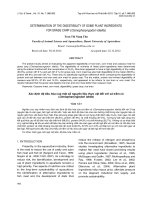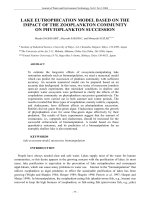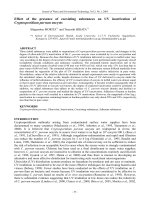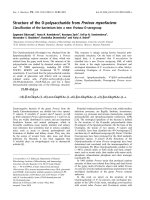Classification of the animal kingdom
Bạn đang xem bản rút gọn của tài liệu. Xem và tải ngay bản đầy đủ của tài liệu tại đây (4.9 MB, 104 trang )
Classification
of the
— ANIMAL
KINGDOM
Richard
E.
Blackwelder
Classification of the Animal
Kingdom
CLASSIFICATION
OF THE
ANIMAL KINGDOM
Richard
E.
Blackwelder
SOUTHERN ILLINOIS UNIVERSITY PRESS
Carbondale,
Illinois
COPYRIGHT
©
1963 by Southern
Illinois
University Press
All rights reserved
LIBRARY OF CONGRESS CATALOG CARD
NUMBER 62-17618
PRINTED IN THE UNITED STATES OF AMERICA
DESIGNED BY ANDOR BRAUN
CONTENTS
INTRODUCTION
1
Simplified List of Recent Phyla
6
Simplified List of Recent Classes
with
and Orders,
Common Names
9
Notes on the Taxa
26
Complete List of Phyla
36
Complete List of Classes and Orders,
with Synonyms, Subgroups, and Geologic Range
39
BIBLIOGRAPHY
72
INDEX TO
COMMON NAMES
INDEX TO LATIN NAMES
75
80
INTRODUCTION
THE CLASSIFICATION OF ANIMALS
is Still
Very
much
a field in which dis-
covery and revision are continuing, even after two hundred years of
The importance
study.
of classification in biology increases every year,
because the experimental and practical fields find increasing need for
accurate identification of animals and for understanding of comparative relationships.
this
At
new
one outstanding biologist has opposed pubUcation of
least
classification
the classification, and
classification
is
on the ground
would tend
finished.
The
that
make
to
it
would be accepted
students think that
intention of the compiler
posite. Just as this classification
ones, so will future editions be
is
is
as final,
higher
all
just the op-
different in detail
from
all
we
learn
more about
still
different, as
previous
the comparative features of animals.
anticipated that every
It is
new
edition will spur students of the
individual groups to propose improvements. It
issue corrected editions
is
therefore planned to
whenever appropriate. The very appearance of
these subsequent editions will emphasize the growth of understanding
of animal groups.
Only one ostensibly complete
fossil,
and
has been published in recent years. That classification, by A.
Duke
Pearse of
specialists.
be,
classification of animals, living
University,
is
a good one, based
Certain mechanical faults
make
it
on
less
the views of
usable than
and the need for revision gave the original impetus
it
S.
many
should
to preparation
of the present classification. Because Pearse did not usually indicate the
source of his arrangements, he
theless, the
two
is
not here cited as an authority. Never-
classifications are basically very similar.
classification has
No
other single
been found that agrees so closely with the conclusions
of the present study.
It
tion
is
nearly
should be emphasized that, within certain
limits, this classifica-
not a simple compilation of the views of specific workers. In
all details,
choices have been
made between
conflicting
schemes
CLASSIFICATION OF THE ANIMAL KINGDOM
of various authors, not
but on
on
my
my
on the
2
basis of the reputation of those authors
judgment of the soundness of
their supporting
analysis of the data they present. In
arguments or
none of the larger groups
has the work of any single author been accepted without modification.
Several considerations have influenced the decisions embodied in
this classification.
a false picture
First,
existing diversity
is
is
given by a simplified classification, because the
one of the principal features of the animal kingdom.
Therefore, no groups should be combined merely for the sake of simplicity.
Second,
although the previous item would seem to require coverage of
the groupings at
and subdivision,
all
show the extreme range of division
possible. Not only are there many
possible levels, to
this
is
not in fact
conflicting groupings at certain levels, such as of phyla or orders, but
there
is
no practical way
tion. It is a
compromise
to
show these groupings
that
is
in a general classifica-
believed to be effective to subdivide the
phyla only into classes, subclasses, and orders. Other possible groupings,
such as subphyla and superorders are referred to in the notes.
Third,
two groups which are so
be described in
common
distinct at
any
level that they
terms must be separated at that
cannot
level.
(For
example, Pterobranchia and Enteropneusta; see the Notes on the Taxa.)
Fourth,
groups which cannot be distinguished at any particular level
by the type of characters used for their neighbors must be combined
that level. (For example, the sometime classes of Nematoda.)
at
the discovery of groupings within a class, for example, does not
Fifth,
new classes for each of the subgroups. The proper
new groups can only be determined by comparison with
justify the creation of
level for the
neighboring parts of the classification.
Sixth,
level
although uniformity in the form (endings) of names at each
would unquestionably be
helpful,
out adding greatly to the total of
it
cannot
now be
attained with-
name forms and synonyms. The
sys-
tems so far proposed are so diverse as to introduce further confusion of
their
own. None of the systems has been widely enough accepted to be
entitled to adoption throughout the
so widely accepted
on a world
basis,
Animal Kingdom. None has been
even
in
one group, as
to indicate
Introduction
3
universal acceptance in the near future. Indeed, even the ordinal endings
in -iformes
adopted by American ichthyologists and ornithologists are
almost entirely unused in the
rest of the world.
resulting
names are
The system does not relieve anyThe latter are used here, with
unnecessarily long and cumbersome.
one from learning the shorter forms
The
also.
the uniform-ending forms listed as synonyms. In other groups, usage
of the source of the classification
cases.
is
There are a variety of systems
ward adoption of any
followed as to spelling, in most
in use
and no obvious trend
to-
single system.
This classification attempts to show the various spellings as well as
the various synonyms.
to use in
each case.
Seventh,
no
Each
zoologist will choose
single rule will suffice for choice of
which one he wishes
names where
several
apply to a single taxon. Reasons for each decision are given in the text
many cases, but in general it has been the goal to
known names, at the most appropriate level, regardless
in
Priority
Eighth,
is
of
homonymy.
considered to be of secondary importance at these levels.
although considerable
to that of
retain the best
phylum names,
homonymy
there
is
exists at all levels,
even up
almost no real confusion caused
thereby. Until there are direct rules to govern the decisions, there seems
to
be nothing gained by replacing well known names, such as Decapoda
Cephalopoda or
(either in the
This classification
in three parts, the purposes of
is
order of preparation, these are:
different. In
tion, including lists of the
mals, living and fossil;
classification;
and
3]
book
is
classes
which are quite
1] the complete classifica-
phyla and of the classes and orders, of
all
ani-
2] the justification for unusual features in this
a simplified classification of Recent animals for
common
student use, with
and of the
in the Crustacea).
names, again including
lists
of the phyla
and orders. The arrangement of these parts
in the
just the reverse of this.
In both
one of these
lists,
is
the phyla are
first
arranged in four subkingdoms, and
divided into four series.
Many
other groupings of these
phyla are possible, and several are shown in the footnotes of the section
Complete List of Phyla.
groupings are of
much
It is
not here believed that these supra-phylum
significance at this phase of the
knowledge of
animals.
In both
ate classes
lists
of orders, these orders are arranged in the appropri-
and subclasses.
No
other levels, such as superorder, are rec-
CLASSIFICATION OF THE ANIMAL KINGDOM
ognized. They may be of use in some circumstances
4
but seem to be of
value in showing the arrangement of the orders on a practical
little
basis.
Throughout, rejected synonyms are printed in
itaUcs, the accepted
names are in capital letters, and the subclass names and the order
names are both set in capitals and lower case letters. In the footnotes,
names that also appear in the classification above are printed in small
capitals. The other names in the footnotes are somewhat in the nature
of rejected synonyms, but as most of them are really the names of nonaccepted groupings, they appear in capitals and lower case roman letters.
class
To
list all
the variety of spellings there
is
no end.
No
attempt
is
made
to
forms, but such spellings as would appear at a separate place in
an alphabetical index are
used for distinct
listed,
levels; e.g.,
along with those variations that are
Echiuroidea (phylum), Echiurida (class),
and Echiuroina (order).
In the Complete List of Orders the geologic range of each group
is shown by symbols at the right margin. The meaning of these symbols
is
shown
in the following table.
Jurassic
Pliocene
JUR
mes
per
pen
Oligocene
mis
Mississippian
Mio
EOC
ter
Miocene
car
dev
Devonian
Tertiary
sil
Silurian
CEN
Cenozoic
ord
Ordovician
CRE
Cretaceous
cam
Cambrian
TRI
Triassic
pal
Paleozoic
REC
QUA
PLE
Recent
PLI
OLI
Quaternary
Pleistocene
Eocene
(+
Paleocene)
Mesozoic
Permian
Pennsylvanian
Carboniferous
There are a few points of discrepancy between the Simplified List
and the Complete
list
more
List.
These are intentional,
useful to students.
classification that
is
The Complete
to
List
make
the simplified
shows the
definitive
here being proposed.
The names included under
the footnote heading "Includes"
may
be suborders, synonyms, rejected groups, or names of questionable ap-
They
orders or more
plication.
their
names which have at some time been used for
inclusive groups and are included merely to indicate
are
all
approximate position
in the
scheme.
Introduction
5
Several recent schemes of classification in particular groups are
known
to the
Some were not
tology).
Some were
received
W of the Treatise of Invertebrate
Paleon-
compiler but are not followed herein.
too late for study (e.g., part
yet available in the
and so were not considered
(e.g.,
form needed for our use
Echinodermata by H. B. Fell and
Mollusca by Taylor and Sohl). There
is
no judgment of these schemes
implied in this action; they will be considered for a subsequent revised
edition.
It will
probably be thought by some that
cation in separating
believes that
it
is
many
this is
an extreme
classifi-
The compiler
small groups as distinct phyla.
a conservative classification even in this regard.
He
believes that an important basic tenet of classification, too often over-
looked,
is
that all groups
must be
distinct
and definable and
fore forms are not to be forced into existing groups at
they do not agree with what are
that group.
The important
the group to be set aside
It is
deemed
any
level
if
be the important features of
features in this case are those
and maintained
sometimes possible to enlarge
definition to
to
that there-
which caused
as distinct.
slightly the
admit forms previously unknown, but
scope of a group
this
does not justify
including widely divergent forms that cannot be defined together effectively.
Simplified List
Subk
Series
Phylum
Kingdom
AN MALI A^
I
EOZOA
Protozoa
^
[one-celled animals]
^
PARAZOA
Porifera
sponges
AGNOTOZOA
Mesozoa
HISTOZOA
(Metazoa)
Enterocoela
Monoblastozoa
Coelenterata (Cnidaria)
hydroids, jellyfish, medusae, corals,
sea-anemones
Ctenophora
comb-jellies, sea-walnuts
Acoelomata
Platyhelminthes
flatworms
Rhynchocoela (Nemertinea)
ribbon-worms, proboscis-worms
Pseudocoelomata
Acanthocephala
spiny-headed-worms
Rotifera (Rotatoria)
rotifers,
wheel-animalcules
Gastrotricha
Kinorhyncha (Echinodera)
Priapuloidea
Nematoda
thread-worms, round-worms
Gordiacea (Nematomorpha)
gordian-worms
Calyssozoa (Endoprocta)
horsehair- worms,
—
of
Subk
Series
Recent Phyla
Phylum
Coelomata
Bryozoa (Ectoprocta)
moss-animals
Phoronida
Brachiopoda
MoUusca
lamp-shells
mollusks
Sipunculoidea
Echiuroidea
Myzostomida
Annelida
[segmented worms]
Tardigrada
bear-animalcules, water-bears
Pentastomida
Onychophora
Arthropoda
crustaceans, arachnids, insects, etc.
Chaetognatha
arrow-worms
Pogonophora
beard-worms
Echinodermata
Pterobranchia
Enteropneusta
Planctosphaeroidea
Tunicata
sea-squirts
Cephalochordata
Vertebrata
^
lancelets
vertebrates
For explanations, other synonyms, extinct groups, and other taxa above the
section Complete List of Phyla.
are sometimes placed in a separate kingdom of organisms
phylum level, see the
^The Protozoa
the Protista.
^ Non-Latin names can be made for each phylum
by merely using the English
form of the name, such as protozoans for Protozoa or arthropods for Arthropoda.
These are listed only where they are in common use.
Recent Classes and Orders
Simplified List of
Common Names
with
Class
Subcl
Order
PROTOZOA
FLAGELLATA
(Mastigophora)
Phytomastigina
flagellates
[plant-like flagellates]
Chrysomonadina
silicoflageUates, etc.
Coccolithophorida
coccolithophores, coccoliths
Cryptomonadina
Phytomonadina
(
Volvocales)
Euglenoidina
Chloromonadina
Dinoflagellata
Zoomastigina
dinoflagellates
[animal-like flagellates]
Rhizomastigina
Protomonadina
Polymastigina
Hypermastigina
SARCODINA
Rhizopoda
rhizopods
Proteomyxa
Mycetozoa
slime-molds
Amoebozoa
Testacea
foraminiferans, forams
Foraminifera
Actinopoda
Heliozoa
sun-animalcules
Radiolaria
radiolarians
SPOROZOA
Telosporidia
Gregarinida
Coccidia
Haemosporidia
Cnidosporidia
Myxosporidia
Actinomyxidia
SIMPLIFIED LIST OF RECENT CLASSES AND ORDERS
Class
Subcl
Order
Microsporidia
microsporidians
Helicosporidia
Sarcosporidia
Sarcosporidia
Globidia
Haplosporidia
Haplosporidia
CILIATA
ciliates
Protociliata
Opalinida
opalinids
Euciliata
Holotricha
Spirotricha
tintiimids, etc.
Chonotricha
Peritricha
SUCTORIA
Suctoria
PORIFERA
sponges
CALCAREA
(Calcispongea)
[calcareous sponges, chalky sponges]
Solenida
Lebetida
Pharetronida
Thalamida
HYALOSPONGEA
(Hexactinellida)
glass-sponges
Lyssakina
Dictyonina
Lychniskophora
Heteractinida
DEMOSPONGEA
Myxospongida
Keratosida
horny-sponges
Haplosclerida
Poecilosclerida
Hadromerida
Halichondrida
Epipolasida
Choristida
Carnosida
Lithistlda
stone-sponges
10
1
Porifera
1
Class
— Coelenterata
Order
Subcl
ESOZOA
M
RHOMBOZOA
Dicyemida
Heterocyemida
ORTHONECTIDA
Orthonectida
MONOBLASTOZOA
MONOBLASTOIDEA
Monoblastidea
COELENTERATA
(Cnidaria)
coelenterates,
medusae
HYDROZOA
Trachylinida
Hydroida
Milleporida (Hydrocorallinae)
millepores
Stylasterina
Siphonophora
SCYPHOZOA
siphonophores
jellyfishes
Stauromedusae
Cubomedusae
Coronatae
Semaeostomeae
Rhizostomeae
ANTHOZOA
sea-anemones, corals
Alcyonaria
Stolonifera
Telestacea
Alcyonacea
soft-corals
Coenothecalia
Gorgonacea
blue-corals
sea-fans,
Pennatulacea
horny-corals,
gorgonians,
sea-feathers
sea-pens, sea-pansies
Zoantharia
Zoanthiniaria
CoraUimorpharia
Actiniaria
sea-anemones
Scleractinia (Madreporaria)
hexacorals, stony-corals
SIMPLIFIED LIST OF RECENT CLASSES AND ORDERS
Class
Subcl
Order
Ceriantipatharia
black-corals, thomy-corals
Antipatharia
Ceriantharia
CTENOPHORA
comb-jellies, sea-walnuts
TENTACULATA
Cydippida
Lobata
Cestida
Platyctenea
NUDA
Beroida
PLATYH ELMINTHES
flatworms
TURBELLARIA
planarians
Acoela
Rhabdocoela
Alloeocoela
Tricladida
triclads
Polycladida
TREMATODA
polyclads
flukes
Monogenea
Aspidogastrea
Digenea
CESTODA
tapeworms
Proteocephala
Tetraphyllidea
Disculicepitidea
Lecanicephala
Trypanorhyncha
Cyclophyllidea
Aporidea
Nippotaeniidea
Caryophyllidea
Spathebothridea
Pseudophyllidea
CESTODARIA
Amphilinidea
Gyrocotylidea
Biporophyllidea
12
3
Ctenophora
1
Class
Subcl
Order
RH YNCHOCOELA
ribbon-worms, proboscis-worms
NEMERTINEA
Palaeonemertea
Heteronemertea
Hoplonemertea
Bdellonemertea
ACANTHOCEPHALA
spiny-headed-worms
ACANTHOCEPHALA
Archiacanthocephala
Palaeacanthocephala
Eoacanthocephala
ROTI FERA
(Rotatoria)
rotifers,
wheel-animalcules
SEISONIDEA
Seisonacea
BDELLOIDEA
Bdellacea
MONOGONONTA
Ploima
Flosculariacea
Collothecacea
GASTROTRICHA
gastrotrichs
MACRODASYOIDEA
Macrodasyidea
CHAETONOTOIDEA
Chaetonotidea
KINORHYNCHA
ECHINODERA
Echinodera
— Kinorhyncha
SIMPLIFIED LIST OF RECENT CLASSES AND ORDERS
Class
Subcl
Order
PRIAPULOI DEA
PRIAPULOIDEA
Priapulida
NEMATODA
nematodes, nemas, thread-worms, round-worms
NEMATOIDEA
Enoploidea
Dorylaimoidea
Mermithoidea
Chromadoroidea
Araeolaimoidea
Monhysteroidea
Desmoscolecoidea
Rhabditoidea
Rhabdiasoidea
Oxyuroidea
Ascaroidea
Strongyloidea
Spiruroidea
Dracunculoidea
Filarioidea
Trichuroidea
Dioctophymoidea
GOR DIACEA
gordian-worms, horsehair-worms
NEMATOMORPHA
Gordioidea
Nectonematoidea
CALYSSOZOA
endoprocts
ENDOPROCTA
(Entoprocta)
Pedicellinida
14
Priapuloidea
15
Class
Subcl
— Mollusca
Order
BR YOZOA
sea-mats, corallines, moss-animals, bryozoans, sea-mosses
PHYLACTOLAEMATA
Lophopoda
GYMNOLAEMATA
Cyclostomata
Ctenostomata
Cheilostomata
PHORON DA
I
phoronids
PHORONIDA
Phoronida
BR ACH lOPO DA
lamp-shells, brachiopods
INARTICULATA
Atremata
Neotremata
ARTICULATA
Protremata
Telotremata
MOLLUSCA
mollusks
MONOPLACOPHORA
Tryblidioidea
AMPHINEURA
chitons
Neoloricata
APLACOPHORA
(Solenogastres)
Neomeniida
Chaetodermatida
GASTROPODA
snails, slugs,
gastropods
Prosobranchia
Archaeogastropoda
limpets, ear-shells, turbans
Caenogastropoda
Opisthobranchia
Pleurocoela
sea-hares
SIMPLIFIED LIST OF RECENT CLASSES AND ORDERS
Class
Subcl
Order
Pteropoda
butterfly-shells,
pteropods
Sacoglossa
nudibranchs
Acoela
Pulmonata
BIVALVIA
land-snails, slugs
Basommatophora
boat-shells,
Stylommatophora
slugs
ramshorns
(Pelecypoda, Lamellibrcmchiata)
bivalves, oysters, clams,
mussels, pelecypods
Protobranchia
Filibranchia
Eulamellibranchia
Septibranchia
SCAPHOPODA
tooth-shells, tusk-shells
Scaphopoda
CEPHALOPODA
cephalopods
Tetrabranchiata
pearly-nautilus
Nautiloidea
Dibranchiata
Decapoda
squids, cuttle-fish
Octopoda
octopuses, argonauts
Vampyromorpha
SIPUNCULOIDEA
[sipunculid
worms]
SIPUNCULOIDEA
Sipunculida
ECHI
U
ROI DEA
ECHIURIDA
Echiuroina
Xenopneusta
Heteromyota
SACCOSOMATIDA
Saccosomatida
M
YZOSTOM DA
I
MYZOSTOMIDA
Proboscidea
Pharyngidea
ANNELIDA
[segmented worms] annelids
7
Sipunculoidea
1
Class
Subcl
— Arthropoda
Order
CHAETOPODA
Polychaeta
polychaetes
Errantia
Sedentaria
sandworms
tubeworms
earthworms, angle-worms, night-crawlers, oligochaetes
Oligochaeta
Plesiothecata
Prosothecata
Prosopora
Opisthopora
HIRUDINEA
leeches, bloodsuckers
Rhynchobdellida
Gnathobdellida
Pharyngobdellida
Acanthobdellida
ARCHIANNELIDA
Archiannelida
TAR DIGRADA
bear-animalcules, water-bears
HETEROTARDIGRADA
Arthrotardigrada
Echiniscoidea
EUTARDIGRADA
Eutardigrada
PENTASTOM DA
I
LINGUATULIDA
Cephalobaenida
Porocephalida
ONYCHOPHORA
PERIPATIDEA
Euonychophora
ARTHROPODA
arthropods
MEROSTOMATA
Xiphosura
Xiphosurida
PYCNOGONIDA
horseshoe-crabs
sea-spiders
Eupantopoda









